 W
WThe Eastern Front of World War II was a theatre of conflict between the European Axis powers against the Soviet Union (USSR), Poland and other Allies, which encompassed Central Europe, Eastern Europe, Northeast Europe (Baltics), and Southeast Europe (Balkans) from 22 June 1941 to 9 May 1945. It was known as the Great Patriotic War in the Soviet Union and some of its successor states, while everywhere else it was called the Eastern Front.
 W
WThe Eastern Front of World War II was a theatre of conflict between the European Axis powers against the Soviet Union (USSR), Poland and other Allies, which encompassed Central Europe, Eastern Europe, Northeast Europe (Baltics), and Southeast Europe (Balkans) from 22 June 1941 to 9 May 1945. It was known as the Great Patriotic War in the Soviet Union and some of its successor states, while everywhere else it was called the Eastern Front.
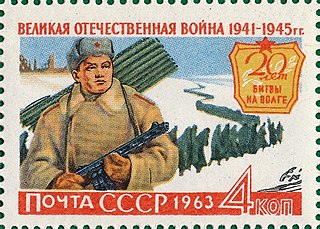 W
WThe Great Patriotic War is a term used in Russia and some other former republics of the Soviet Union to describe the conflict fought during the period from 22 June 1941 to 9 May 1945 along the many fronts of the Eastern Front of World War II, primarily between the Soviet Union and Nazi Germany. For some legal purposes, this period may be extended to 11 May 1945 to include the end of the Prague Offensive.
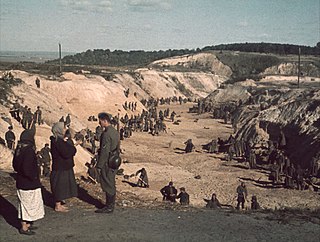 W
WBabi Yar is a ravine in the Ukrainian capital Kyiv and a site of massacres carried out by Nazi Germany's forces during its campaign against the Soviet Union in World War II. The first and best documented of the massacres took place on 29–30 September 1941, killing approximately 33,771 Jews. The decision to kill all the Jews in Kyiv was made by the military governor Generalmajor Kurt Eberhard, the Police Commander for Army Group South, SS-Obergruppenführer Friedrich Jeckeln, and the Einsatzgruppe C Commander Otto Rasch. Sonderkommando 4a as the sub-unit of Einsatzgruppe C, along with the aid of the SD and Order Police battalions with the Ukrainian Auxiliary Police backed by the Wehrmacht, carried out the orders. Sonderkommando 4a and the 45th Battalion of the German Order Police conducted the shootings. Servicemen of the 303rd Battalion of the German Order Police at this time guarded the outer perimeter of the execution site.
 W
WThe Battle of Russia (1943) is the fifth film of Frank Capra's Why We Fight documentary series. The longest film of the series, it has two parts. It was made in collaboration with Lithuania-born Anatole Litvak as primary director under Capra's supervision. Litvak gave the film its "shape and orientation," and the film had seven writers with voice narration by Walter Huston. The score was done by the Russian-born Hollywood composer Dimitri Tiomkin and drew heavily on Tchaikovsky along with traditional Russian folk songs and ballads.
 W
WThe Belgrade Military Parade, known as Korak pobednika, was a military parade on Nikola Tesla Boulevard on 16 October 2014, during the 70th anniversary of the liberation of Belgrade. The city was liberated from the hands of the Nazis by the Yugoslav Partisans with the help of the Red Army during the Belgrade Offensive on 20 October 1944. It was the first military parade in the country for 30 years, and included 4,500 Serbian troops, as well as a minor number of Russian troops and the Russian aerobatic team, Swifts. President Tomislav Nikolić and Prime Minister Aleksandar Vučić attended the parade, with Russian President Vladimir Putin attending as the guest of honour. Participants in the parade were given awards for their participation, in December at Topčider.
 W
WThe Spanish Volunteer Medal formally known as the Commemorative Medal for Spanish Volunteers in the Struggle Against Bolshevism , commissioned 3 January 1944, was awarded by the Third Reich to recognize the men of the Blue Division who served at the Russian front during World War II. This force, attached to the Heer of the Wehrmacht, known as the 250th Infantry Division (span.), was in total composed of 47,000 men, sent by Francisco Franco to aid the Third Reich, as a way to pay back Adolf Hitler's help during the Spanish Civil War.
 W
WDuring World War II, losses of major items of equipment were substantial in many battles all throughout the war, with no exception on the Eastern Front. Due to the expense of producing such equipment as replacements, many armies made an effort to recover and re-use enemy equipment that fell into their hands, applicable to both Nazi Germany and the Soviet Union.
 W
WThe Commissar Order was an order issued by the German High Command (OKW) on 6 June 1941 before Operation Barbarossa. Its official name was Guidelines for the Treatment of Political Commissars. It instructed the Wehrmacht that any Soviet political commissar identified among captured troops be summarily executed as a purported enforcer of the "Judeo-Bolshevism" ideology in military forces. It is one of a series of criminal orders issued by the leadership.
 W
WThe Generalplan Ost, abbreviated GPO, was the Nazi German government's plan for the genocide and ethnic cleansing on a vast scale, and colonization of Central and Eastern Europe by Germans. It was to be undertaken in territories occupied by Germany during World War II. The plan was attempted during the war, resulting indirectly and directly in the deaths of millions by shootings, starvation, disease, extermination through labor, and genocide. But its full implementation was not considered practicable during the major military operations, and was prevented by Germany's defeat.
 W
WPrior to the invasion of the Soviet Union during World War II, the German armed forces were not aware of two newly developed Soviet tanks, the T-34 and the KV. As a result, they were surprised when they met them in combat for the first time in June 1941. The Germans' standard anti-tank weapons were found to be ineffective against these new Soviet vehicles. This experience prompted a notable leap in tank development in Nazi Germany, mainly in an effort to counter these new threats.
 W
WApproximately three million German prisoners of war were captured by the Soviet Union during World War II, most of them during the great advances of the Red Army in the last year of the war. The POWs were employed as forced labor in the Soviet wartime economy and post-war reconstruction. By 1950 almost all surviving POWs had been released, with the last prisoner returning from the USSR in 1956. According to Soviet records 381,067 German Wehrmacht POWs died in NKVD camps. According to German historian Rüdiger Overmans ca. 3,000,000 POW were taken by the USSR; he put the "maximum" number of German POW deaths in Soviet hands at 1.0 million. Based on his research, Overmans believes that the deaths of 363,000 POWs in Soviet captivity can be confirmed by the files of Deutsche Dienststelle (WASt), and additionally maintains that "It seems entirely plausible, while not provable, that 700,000 German military personnel listed as missing actually died in Soviet custody."
 W
WThe German-Russian Museum Berlin-Karlshorst is dedicated to German-Soviet and German-Russian relations with a focus on the German-Soviet war 1941-1945.
 W
WThe Gyorshadtest was the most modern and best-equipped mechanized unit of the Royal Hungarian Army at the beginning of World War II. However, the "Rapid Corps" name was something of a misnomer as it was only "mechanized" compared to other Hungarian units. The corps was not particularly mechanized when compared to similar units fielded by countries like Germany or the Soviet Union.
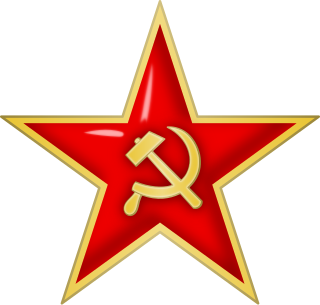 W
WThe Headquarters of the Supreme High Command was an extraordinary body of the highest military command, exercising strategic leadership of the Soviet Armed Forces during the Great Patriotic War.
 W
WThe Holocaust in Estonia refers to the Nazi crimes during the occupation of Estonia by Nazi Germany. Prior to the war, there were approximately 4,300 Estonian Jews. After the 1940 Soviet occupation, about 10% of the Jewish population was deported to Siberia, along with other Estonians. About 75% of Estonian Jews, aware of the fate that awaited them from Nazi Germany, escaped to the Soviet Union; virtually all of those who remained were killed by Einsatzgruppe A and local collaborators before the end of 1941. Roma people of Estonia were also murdered and enslaved by the Nazi occupiers and their collaborators. The Nazis and their allies also killed around 6,000 ethnic Estonians and 1,000 ethnic Russians who were accused of being communist sympathizers or the relatives of communist sympathizers. In addition around 15,000 Soviet prisoners-of-war and Jews from other parts of Europe were killed in Estonia during the German occupation.
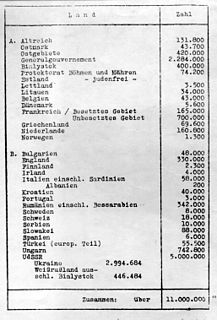 W
WThe Holocaust in Latvia refers to the crimes against humanity committed by Nazi Germany and collaborators victimizing Jews during the occupation of Latvia.
 W
WThe Holocaust in Russia is the Nazi crimes during the occupation of Russia by Nazi Germany.
 W
WThe Holocaust in Ukraine took place in the Reichskommissariat Ukraine, the General Government, Crimean General Government and some areas under military control to the East of Reichskommissariat Ukraine and as well in the Transnistria Governorate and Northern Bukovina and Carpathian Ruthenia in World War II. Between 1941 and 1944, more than a million Jews living in the Soviet Union were murdered by Nazi Germany's "Final Solution" extermination policies. Most of them were killed in Ukraine because most pre-WWII Soviet Jews lived in the Pale of Settlement, of which Ukraine was the biggest part.
 W
WThe Italian participation in the Eastern Front represented the military intervention of the Kingdom of Italy in the Operation Barbarossa, launched by Nazi Germany against the Soviet Union in 1941. The commitment to actively take part in the German offensive was decided by Benito Mussolini a few months before the beginning of the operation, when he became aware of Adolf Hitler's intention to invade, but it was confirmed only in the morning of 22 June 1941, as soon as the Italian dictator was informed that same day the German armies had given way to the invasion.
 W
WKhatyn was a village of 26 houses and 157 inhabitants in Belarus, in Lahoysk Raion, Minsk Region, 50 km away from Minsk. On 22 March 1943, almost the entire population of the village was massacred by the Schutzmannschaft Battalion 118 in retaliation for an attack on German troops by Soviet partisans. The battalion was composed of Nazi collaborators and assisted by the Dirlewanger Waffen-SS special battalion.
 W
WThe Kuban Bridgehead, also known as the "Goth's head position", was a German military position on the Taman Peninsula, Russia, between the Sea of Azov and the Black Sea. Existing from January to October 1943, the bridgehead formed after the Germans were pushed out of the Caucasus. The heavily fortified position was intended as a staging area for the Wehrmacht which was to be used to renew attacks towards the oil wells of the Caucasus. The bridgehead was abandoned when the Red Army breached the Panther–Wotan line, forcing an evacuation of the German forces across the Kerch Strait to Crimea.
 W
WAfter the occupation of Latvia by the USSR in June 1940, much of the previous Latvian army was disbanded and many of its soldiers and officers were arrested and imprisoned or executed. The following year Nazi Germany occupied Latvia during the offensive of Army Group North. The German Einsatzgruppen were aided by a group known as Arajs Kommando in the killing of Latvian Jews as part of the Holocaust. Latvian soldiers fought on both sides of the conflict against their will, and in 1943 180,000 Latvian men were drafted into the Latvian Legion of the Waffen-SS and other German auxiliary forces.
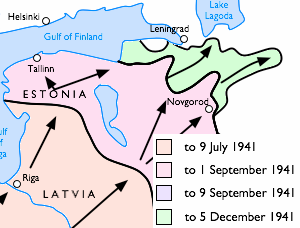 W
WLeningrad strategic defensive operation is the term in Soviet historiography for the defensive operations in the area south of Leningrad by the Red Army and the Soviet Navy during World War II from 10 July to 30 September 1941. The following operations are considered as part of the strategic operation:Kingisepp–Luga defensive 10 July – 23 September 1941 Soltsy–Dno offensive 14–22 July 1941 Tallinn defensive 5– 28 August 1941 Staraya–Russa offensive 8–23 August 1941 Demyansk defensive 6–26 September 1941
 W
WIn July 1941, 25 Polish academics from the city of Lwów along with their families were killed by Nazi German occupation forces. By targeting prominent citizens and intellectuals for elimination, the Nazis hoped to prevent anti-Nazi activity and to weaken the resolve of the Polish resistance movement. According to an eyewitness the executions were carried out by an Einsatzgruppe unit under the command of Karl Eberhard Schöngarth with the participation of Ukrainian translators in German uniforms.
 W
WThe Medalla de la campaña de Rusia, commissioned 9 November 1943, was awarded by Nationalist Spain to those Spanish volunteers who served at the Russian front during World War II, as members of the Blue Division. This force, attached to the Heer of the Wehrmacht, known as the 250th Infantry Division (span.), was in total composed of 47,000 men, sent by Francisco Franco to aid the Third Reich, as a way to pay back Adolf Hitler's help during the Spanish Civil War.
 W
WThe Mizoch (Mizocz) Ghetto was a World War II ghetto set up in the town of Mizoch, Western Ukraine by Nazi Germany for the forcible segregation and mistreatment of Jews.
 W
WThe Moscow Victory Parade of 1945 also known as the Parade of Victors was a victory parade held by the Soviet Armed Forces after the defeat of Nazi Germany. This, the longest and largest military parade ever held on Red Square in the Soviet capital Moscow, involved 40,000 Red Army soldiers and 1,850 military vehicles and other military hardware. The parade lasted just over two hours on a rainy June 24, 1945, over a month after May 9, the day of Germany's surrender to Soviet commanders.
 W
WMount Sapun or Sapun Ridge is a 240 m high ridge to the southeast of Sevastopol, situated on the disputed Crimean peninsula.
 W
WOperation Orator was the code name for the defence of the Allied Arctic convoy PQ 18 by British and Australian air force units based temporarily in North-West Russia, against attack by the German battleship Tirpitz and other Kriegsmarine surface vessels. The wing, known as the Search & Strike Force, was commanded by Group Captain Frank Hopps and its maritime strike element was the Leuchars Wing, comprising No. 144 Squadron, Royal Air Force (RAF) and No. 455 Squadron, Royal Australian Air Force (RAAF) equipped with Handley-Page Hampden TB 1 torpedo bombers.
 W
WOrder No. 227 was an order issued on 28 July 1942 by Joseph Stalin, who was acting as the People's Commissar of Defence. It is known for its line "Not a step back!", which became the primary slogan of the Soviet press in summer 1942.
 W
WThis is the order of battle for Operation Barbarossa, the German invasion of the Soviet Union during World War II. It was fought between the German-led Axis Forces and the Soviet Forces. The operation started on June 22, 1941, and ended on December 5, 1941, at the conclusion of Operation Typhoon.
 W
WOstarbeiter was a Nazi German designation for foreign slave workers gathered from occupied Central and Eastern Europe to perform forced labor in Germany during World War II. The Germans started deporting civilians at the beginning of the war and began doing so at unprecedented levels following Operation Barbarossa in 1941. They apprehended Ostarbeiter from the newly-formed German districts of Reichskommissariat Ukraine, District of Galicia, and Reichskommissariat Ostland. These areas comprised German-occupied Poland and the conquered territories of the Soviet Union. According to Pavel Polian, over 50% of Ostarbeiters were formerly Soviet subjects originating from the territory of modern-day Ukraine, followed by Polish women workers. Eastern workers included ethnic Ukrainians, Poles, Belarusians, Russians, Armenians, Tatars, and others. Estimates of the number of Ostarbeiter range between 3 million and 5.5 million.
 W
WOur Russian Front is a 1942 American documentary film directed by Joris Ivens and Lewis Milestone, and narrated by Walter Huston to promote support for the Soviet Union's war effort.
 W
WThe Panfilov Division's Twenty-Eight Guardsmen, commonly referred to simply as Panfilov's Twenty-Eight Guardsmen, Panfilov's Men, or just the Twenty-Eight, were a group of soldiers from the Red Army's 316th Rifle Division who took part in the Battle of Moscow during World War II. According to official Soviet history which was later shown to be false, they were all killed in action on 16 November 1941, after destroying 18 German tanks and stopping the enemy attack; the Twenty-Eight were collectively endowed with the title Hero of the Soviet Union.
 W
WPanzer Campaigns: Smolensk '41 is video game released in 1999, and is part of the Panzer Campaigns video game series.
 W
WVictory Day Parades are common military parades that are held on 9 May in some post-soviet nations, primarily Russia, Kazakhstan, Belarus, and formerly Ukraine. They are usually held to honor the traditional Victory Day holiday. In 2015, the Ukrainian government had renamed the holiday as "Victory Day over Nazism in World War II" as part of decommunization laws. However, even after the change, a vast amount of the populace still honors Ukrainian-Soviet troops who fought in World War II with traditional Victory Day celebrations.
 W
WDuring World War II, Nazi Germany engaged in a policy of deliberate maltreatment of Soviet prisoners of war (POWs), in contrast to their treatment of British and American POWs. This policy, which amounted to deliberately starving and working to death Soviet POWs, was grounded in Nazi racial theory, which depicted Slavs as sub-humans (Untermenschen). The policy resulted in some 3.3 to 3.5 million deaths.
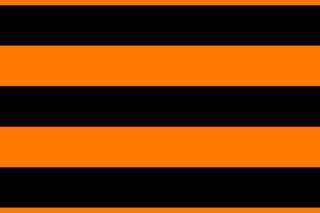 W
WThe ribbon of Saint George is a Russian military symbol consisting of a black and orange bicolour pattern, with three black and two orange stripes. It appears as a component of many high military decorations awarded by the Russian Empire, the Soviet Union and the current Russian Federation.
 W
WThe Rumbula massacre is a collective term for incidents on November 30 and December 8, 1941, in which about 25,000 Jews were killed in or on the way to Rumbula forest near Riga, Latvia, during the Holocaust. Except for the Babi Yar massacre in Ukraine, this was the biggest two-day Holocaust atrocity until the operation of the death camps. About 24,000 of the victims were Latvian Jews from the Riga Ghetto and approximately 1,000 were German Jews transported to the forest by train. The Rumbula massacre was carried out by the Nazi Einsatzgruppe A with the help of local collaborators of the Arajs Kommando, with support from other such Latvian auxiliaries. In charge of the operation was Höherer SS und Polizeiführer Friedrich Jeckeln, who had previously overseen similar massacres in Ukraine. Rudolf Lange, who later participated in the Wannsee Conference, also took part in organizing the massacre. Some of the accusations against Latvian Herberts Cukurs are related to the clearing of the Riga Ghetto by the Arajs Kommando. The Rumbula killings, together with many others, formed the basis of the post-World War II Einsatzgruppen trial where a number of Einsatzgruppen commanders were found guilty of crimes against humanity.
 W
WThe Severity Order or Reichenau Order was the name given to an order promulgated within the German Sixth Army on the Eastern Front during World War II by Generalfeldmarschall Walther von Reichenau on 10 October 1941.
 W
WAfter the United Kingdom, France, and Italy signed with Germany the Munich Agreement on 30 September 1938, which "provided 'cession to Germany of the Sudeten German territory' of Czechoslovakia, despite existence of the 1924 alliance agreement and 1925 military pact between France and the Czechoslovak Republic, for which it is also known also as the Munich Betrayal," almost a year later, the Soviet Union signed a non-aggression pact with Nazi Germany on 23 August 1939. In addition to stipulations of non-aggression, the treaty included a secret protocol that divided territories of Romania, Poland, Lithuania, Latvia, Estonia, and Finland into German and Soviet Union "spheres of influence", anticipating potential "territorial and political rearrangements" of these countries. In October and November 1940, German-Soviet talks about the potential of joining the Axis took place in Berlin, nothing came from the talks since Hitler's Ideological goal was Lebensraum in the East.
 W
WIn Soviet historiography, Stalin's ten blows were the ten successful strategic offensives conducted by the Red Army in 1944 during World War II. The Soviet offensives drove the Axis forces from Soviet territory and precipitated Nazi Germany's collapse.
 W
WThe Soviet evacuation of Tallinn, also called Tallinn disaster or Russian Dunkirk, was a Soviet operation to evacuate the 190 ships of the Baltic Fleet, units of the Red Army, and pro-Soviet civilians from the fleet's encircled main base of Tallinn in Soviet-occupied Estonia during August 1941.
 W
WThe Tuvan People’s Republic entered World War II on the side of the Allied Powers, shortly after the invasion of the Soviet Union by Nazi Germany, breaking the non-aggression pact between the Soviet Union and Third Reich.
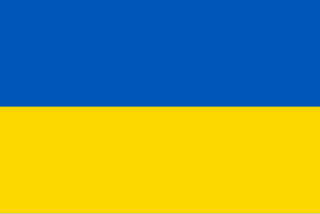 W
WUkraine is a country in Eastern Europe. It is the second-largest country in Europe after Russia, which it borders to the east and north-east. Ukraine also shares borders with Belarus to the north; Poland, Slovakia, and Hungary to the west; Romania and Moldova to the south; and has a coastline along the Sea of Azov and the Black Sea. It spans an area of 603,628 km2 (233,062 sq mi), with a population of 41.3 million, and is the eighth-most populous country in Europe. The nation's capital and largest city is Kyiv.
 W
WThe Unknown War (Russian: "Великая Отечественная" or "Неизвестная война" is an American documentary television series. The 20-part series documents the World War II conflict between Nazi Germany and the Soviet Union. The show was produced and syndicated for international distribution by Air Time International, and the executive producer was Fred Weiner. Each episode is about 48 minutes long, similar in format to The World at War documentary series. The footage was edited from over 3.5 million feet of film taken by Soviet camera crews from the first day of the war during Operation Barbarossa on 22 June 1941 through the Soviet invasion of Manchuria in August 1945. Most of these films have never been seen outside this documentary series.
 W
WThe Zhestianaya Gorka massacre was a World War II massacre of partisans and civilians, mostly women and children, carried out in the village of Zhestianaya Gorka by Schutzmannschaft and Nazi collaborators.